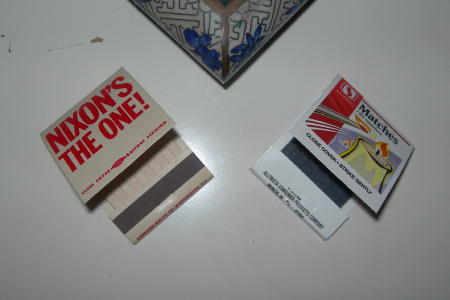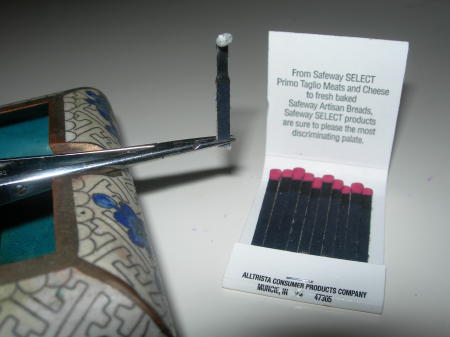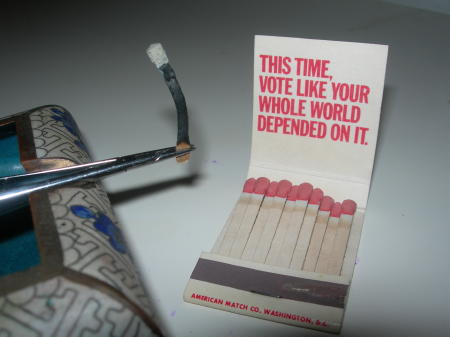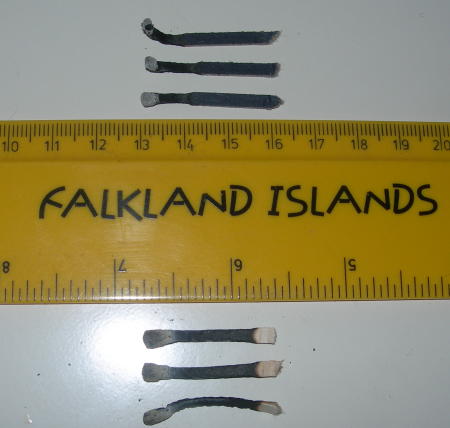





|
|
|
|
February 01, 2007
I know I'm playing with fire... (But 1968 burns better, baby!)
As I'm not a smoker, it has taken me longer to notice this than I should have, but I have become convinced that ordinary paper matches (the kind you buy in the grocery store) simply don't work as well as the ones I remember from the old days. I'm almost inclined to say they just plain suck, but that would be as judgmental as it would be unscientific, and I like to verify my claims when I can. For some time, I've been convinced that not only are matches harder than ever to strike, but they go out before they burn even a quarter of the way down. Or am I imagining things? Were the old matches "better," and are the new matches "worse"? Even those words are problematic, for what do they mean? But before I get to the philosophical and political implications of the word "better," I thought I would start by attempting to find out whether my suspicions about old-versus-new matches were correct. Not wanting to leave anything to chance, I decided to attempt a scientific comparison under controlled conditions in my own home. Because this is a blog, and because blogs can be read and reviewed by other bloggers, I don't think it's too much to claim that this experiment will have been subjected to "peer review" by the time it's over. It just so happens that because I collect things, I have a box of campaign matchbooks from 1968. While I never use them (because their value to collectors would be substantially diminished once they are burned), in this case I decided to make an important exception -- in the interest of science! As it happens, I also have a box of matchbooks from a 2006 store purchase. These are the matches that I use for lighting candles, burned out pilot lights, the hot water heater, and (if I am feeling especially considerate) to destroy unmentionable odors in the bathroom. Here are the scientific contestants -- on each side of the ashtray, and all ready for the game:  Attentive readers may notice that the striking surface is on the front cover of the 1968 matches, and on the reverse cover of the recent matches. That's because of a 1973 federal safety rule. According to collectors' lingo, [the modern matchbooks] are referred to as "back strikers" or "reverse strikers", while pre-1973 covers are called "front strikers".(Just thought you needed to know.) What is beyond my level of knowledge or expertise is the extent to which matches deteriorate over time. For all I know, the 1968 matches would have performed better in 1968 than they do now; the color of the heads seems a little less red than I remember them, but that could be my imagination. In any event, they lit when struck, and as you will see, not only had no problem burning, but far exceeded today's matches. Were matches deliberately made fire retardent over time? If so, at what point? I still don't know for certain, but I was intrigued by this 1976 CPSC notice, which urged the adoption of new regulations requiring matches to not only be made childproof, but fire retardant as well: In view of epidemiological data, consideration of various human factors, an intense study of possible child-resistant requirements and a preliminary assessment of the economic effect on the matchbook industry, the Commission finds a latching cover design requirement to be, at this time, the most feasible means of child resistance. However, it is not the intent of the Commission to exclude other designs that might offer the equivalent child resistance of the latching design. Included in the proposed standard is a procedure for interested persons to submit alternate cover designs for Commission acceptance.Nice to know that matches didn't cause Global Warming in those days, isn't it? Obviously, the childproof "latching cover design" was not implemented. As to whether the self-extinguishing rule was ever enacted, I do not know. However, I can report that (at least in my experiment), when held in place vertically by forceps, the modern matches extinguished themselves in 20 seconds (give or take a second), while the 1968 matches burned for nearly an entire minute (average time 55 seconds), until nearly the entire length of the match was consumed. Here's the 2006 Safeway match: 

Here they are lined up with a ruler -- "Safeway" on top; "Nixon" below: 
(And after all, how many burnouts from 1968 do we need?) I don't even think the match industry would approve of what I did, because they don't want ordinary people thinking their product was "better" in the old days. But my "research" really wasn't intended to make the match industry look bad, nor is it my goal here to castigate "safe" matches. I just wanted to confirm my suspicions, and pose a few questions. What do we mean when we use the word "better"? It's a judgment, and fire marshals and trial lawyers are likely to have a very different view of self-extinguishing matches than I do when I'm crawling around on a cold, damp basement floor in February trying to light the pilot of a hot water heater only to have the damned match go out for the umpteenth time. Older people who remember matches that burned are likely to have a very different view than younger people who probably feel lucky that they're allowed to buy matches at all. But what the hell. I just wanted to know whether matches were better in the old days. If we look at pure functionality, I think my test shows that they were better -- by a large margin. (The deterioration factor would add strength to my argument.) Far be it from me to advocate rolling back the clock to 1968.... I've had enough of 1968 burnouts -- at least for today! posted by Eric on 02.01.07 at 10:40 AM
Comments
I just buy the "strike anywhere" style of matches. Those burn for a decent period of time. I need to get a waterproof holder for the car, though. Or maybe I should just get a flint and stick a Swiss Army Knife in there with it. B. Durbin · February 1, 2007 02:21 PM Yes, you have rediscovered a truth about paper matches. They are meant to stop burning rather quickly, to help avoid inadvertently set fires. I remember this from my college chemistry classes in the early 80's. The same holds true for wooden matches, at least those produced in this country. If you want a real pyromaniacal device, try a foreign cigarette lighter, filled with well-pressurized acetylene. It works like a small welding torch, shooting a tight blue flame 6 inches towards a cigarrette. Austin Mike · February 2, 2007 09:27 AM I know the current strike-anywhere matches don't strike as well as they used to. Firehand · February 2, 2007 09:02 PM As an old "gas guy", try dipping a bamboo skewer in PVC glue right before you try lighting the pilot (blue glue works best). You'll have a good strong fire and a long reach. ...Or you could go for the expensive "extend-a-lights' made specifically for that job. Kurt P · February 3, 2007 11:01 PM Kurt, thanks for the tip! Eric, I love it that you were able to fuse art and science. Who says the two cultures can never meet as friends? J. Case J. Case · February 4, 2007 12:12 PM Post a comment
You may use basic HTML for formatting.
|
|
February 2007
WORLD-WIDE CALENDAR
Search the Site
E-mail
Classics To Go
Archives
February 2007
January 2007 December 2006 November 2006 October 2006 September 2006 August 2006 July 2006 June 2006 May 2006 April 2006 March 2006 February 2006 January 2006 December 2005 November 2005 October 2005 September 2005 August 2005 July 2005 June 2005 May 2005 April 2005 March 2005 February 2005 January 2005 December 2004 November 2004 October 2004 September 2004 August 2004 July 2004 June 2004 May 2004 April 2004 March 2004 February 2004 January 2004 December 2003 November 2003 October 2003 September 2003 August 2003 July 2003 June 2003 May 2003 May 2002 See more archives here Old (Blogspot) archives
Recent Entries
• Duke Fever
• Crime Reporting • Valerie Solanas • End at any cost? • "Into" spilling children's blood? • Palestinian Civil War Watch - 14 • The Christian Thing To Do • Hamas Will Not Harm Democrats • James Lileks and the irrational hatred of perfect strangers • Freewheeling advance of accelerating eliminationist rhetoric!
Links
Site Credits
|
|
I assume the match makers are afraid they
will be held responsible if it is proven that one of their matches starts a fire.
Hugh